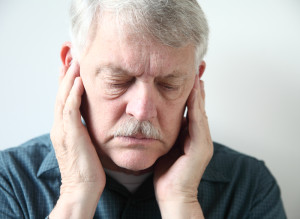Introduction
The patient suffering from tinnitus hears a noise or ringing in the ears.
Objective tinnitus: Some of these noises may be objectively produced in the patient because of patent eustachian tubes or because of vibrations of the soft palate. There are physical reasons for noises that are generated and that are picked up through sound transmission by the inner ear through bony conduction.
Along those lines are vascular noises from carotid artery hardening or from head tumors with a lot of blood vessels. The physician may often be able to hear these noises as well placing a stethoscope on the patient’s head or neck (Ref. 2, p. 1730).
Subjective tinnitus: More often only the patient can hear the tinnitus.
With Menieres disease there is a low pitch, ocean roar like tinnitus, which becomes very loud immediately before a vertigo attack starts. After the attack it can disappear. A continuous high pitched tinnitus on both ears is associated with damage to the hearing cells following explosions, exposure to industrial noises, toxic effects of chemicals or drugs and with general hearing impairment from aging (called “presbycusis”).
Treatment
It is best to go to a university affiliated multidisciplinary tinnitus clinics to have a thorough work-up to rule out any treatable conditions.
One such treatment center can be found under this link (thanks to www.ohsu.edu for this link). When all of the treatable conditions have been ruled out and the tinnitus is still present, there are some special hearing aids that are available. They produce more pleasant background sounds, which can be utilized for blunting of tinnitus.
References:
1. The Merck Manual, 7th edition, by M. H. Beers et al., Whitehouse Station, N.J., 1999. Chapter 84.
2. Noble: Textbook of Primary Care Medicine, 3rd ed.,2001, Mosby Inc.
3. The Merck Manual, 7th edition, by M. H. Beers et al., Whitehouse Station, N.J., 1999. Chapter 85.
4. Rakel: Conn’s Current Therapy 2001, 53rd ed.,2001, W. B. Saunders Company
5. Goldman: Cecil Textbook of Medicine, 21st ed.,2000, W. B. Saunders Company
6. Mandell: Principles and Practice of Infectious Diseases, 5th ed.,2000, Churchill Livingstone, Inc.
7. The Merck Manual, 7th edition, by M. H. Beers et al., Whitehouse Station, N.J., 1999. Chapter 265.
8. MF Williams: Otolaryngol Clin North Am; Oct1999; 32(5): 819-834.
9. The Merck Manual, 7th edition, by M. H. Beers et al., Whitehouse Station, N.J., 1999. Chapter 106.
10. Ferri: Ferri’s Clinical Advisor: Instant Diagnosis and Treatment, 2004 ed., Copyright © 2004 Mosby, Inc.
11. Rakel: Conn’s Current Therapy 2004, 56th ed., Copyright © 2004 Elsevier







